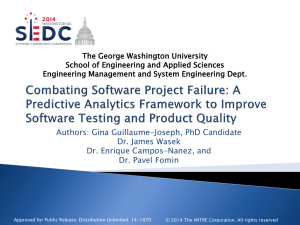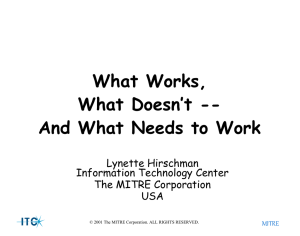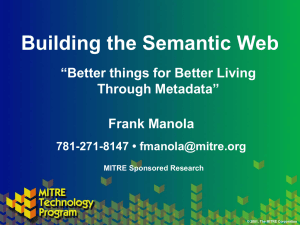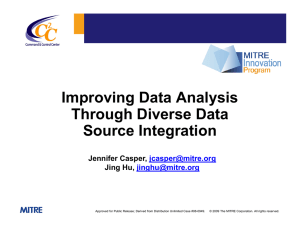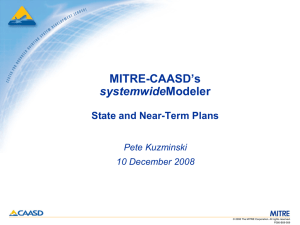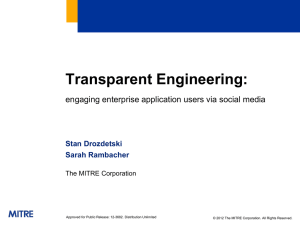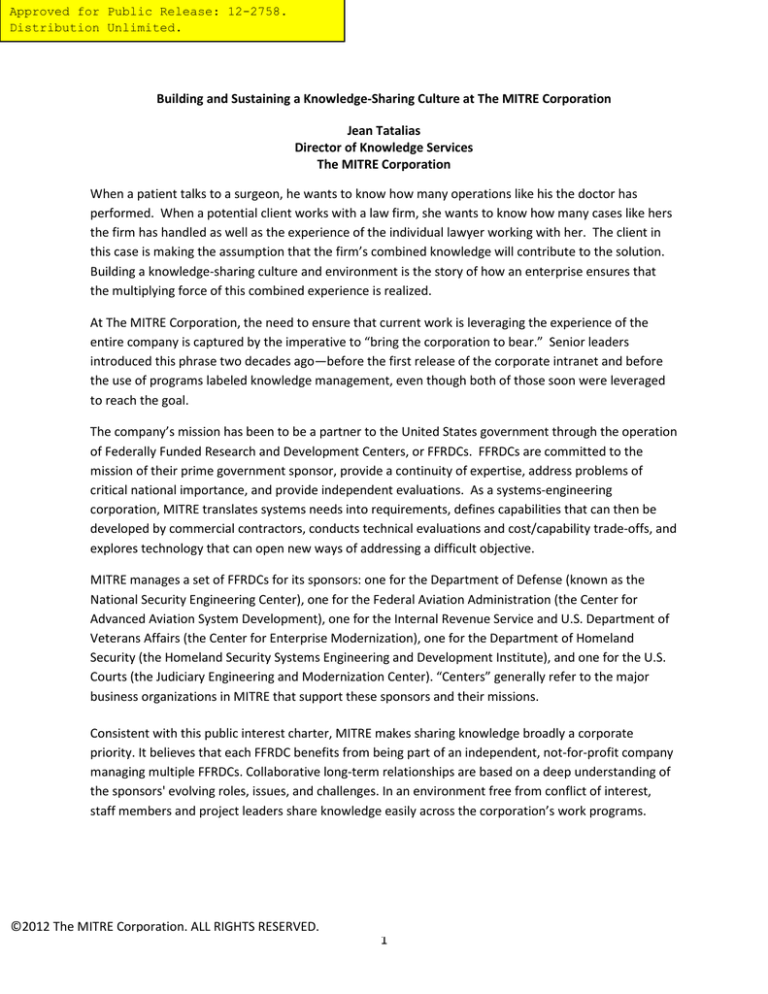
Approved for Public Release: 12-2758.
Distribution Unlimited.
Building and Sustaining a Knowledge-Sharing Culture at The MITRE Corporation
Jean Tatalias
Director of Knowledge Services
The MITRE Corporation
When a patient talks to a surgeon, he wants to know how many operations like his the doctor has
performed. When a potential client works with a law firm, she wants to know how many cases like hers
the firm has handled as well as the experience of the individual lawyer working with her. The client in
this case is making the assumption that the firm’s combined knowledge will contribute to the solution.
Building a knowledge-sharing culture and environment is the story of how an enterprise ensures that
the multiplying force of this combined experience is realized.
At The MITRE Corporation, the need to ensure that current work is leveraging the experience of the
entire company is captured by the imperative to “bring the corporation to bear.” Senior leaders
introduced this phrase two decades ago—before the first release of the corporate intranet and before
the use of programs labeled knowledge management, even though both of those soon were leveraged
to reach the goal.
The company’s mission has been to be a partner to the United States government through the operation
of Federally Funded Research and Development Centers, or FFRDCs. FFRDCs are committed to the
mission of their prime government sponsor, provide a continuity of expertise, address problems of
critical national importance, and provide independent evaluations. As a systems-engineering
corporation, MITRE translates systems needs into requirements, defines capabilities that can then be
developed by commercial contractors, conducts technical evaluations and cost/capability trade-offs, and
explores technology that can open new ways of addressing a difficult objective.
MITRE manages a set of FFRDCs for its sponsors: one for the Department of Defense (known as the
National Security Engineering Center), one for the Federal Aviation Administration (the Center for
Advanced Aviation System Development), one for the Internal Revenue Service and U.S. Department of
Veterans Affairs (the Center for Enterprise Modernization), one for the Department of Homeland
Security (the Homeland Security Systems Engineering and Development Institute), and one for the U.S.
Courts (the Judiciary Engineering and Modernization Center). “Centers” generally refer to the major
business organizations in MITRE that support these sponsors and their missions.
Consistent with this public interest charter, MITRE makes sharing knowledge broadly a corporate
priority. It believes that each FFRDC benefits from being part of an independent, not-for-profit company
managing multiple FFRDCs. Collaborative long-term relationships are based on a deep understanding of
the sponsors' evolving roles, issues, and challenges. In an environment free from conflict of interest,
staff members and project leaders share knowledge easily across the corporation’s work programs.
©2012 The MITRE Corporation. ALL RIGHTS RESERVED.
1
The Knowledge-Sharing Challenge
Early in the 1990s, senior leadership began to voice a strategy of finding the right expertise in the
company for each project. They motivated managers to apply the best skills to their projects, wherever
those skills resided, regardless of employees’ geographic or organizational location. “Bringing the
corporation to bear” enables every staff member to tap the expertise of the entire company and use the
experience gained in prior or concurrent work projects. Managers carried a responsibility to actively link
staff members to relevant experts and projects for this purpose. Employees placed value on being
connected. To supplement individual manager connections, the company created skill-centric
organizations of expertise, from which staff members with a particular expertise would assist projects
across the company. But these organizational-centric methods had limits; they did not reach far enough
or connect enough projects to the breadth of knowledge developed in the company. As the size of the
corporation increased and the scope of the government customer base grew, MITRE needed more ways
to extend the human network.
One of MITRE’s early challenges in building a knowledge-sharing culture was the fact that in addition to
organizational separations, geographic ones also existed, relating to the company’s two major locations.
There are also a number of distributed sites, many of which existed 20 years ago. But in those years,
many sites were smaller and narrowly associated with a specific project. In addition to the physical
separation, the company’s organizational structure was largely by customer base. The different
locations tried to be physically close to their customers, and thus the work was segregated along
customer as well as geographic lines. Most staff members were unfamiliar with the work of other
locations; many lacked a natural interest in obtaining a broader view. In such an environment, building
trust in the work or expertise of staff members from other parts of the company was difficult; lack of
visibility impeded the mutual trust and perceived value required to build knowledge sharing.
The corporation had two main strategies to address this. One was to overcome the technical constraints
to collaboration and communication by removing technical barriers as discussed in the next section. The
second strategy used the theme of “bringing the corporation to bear” and applied a set of knowledge
management methods which connected people through shared knowledge content and which are the
focus of this chapter.
An evolving environment also drove the need for change. While MITRE generally enjoys long average
employee tenure, in 2004, 40 percent of the workforce had been with the company less than five years,
due to corporate growth. These employees did not have the length of service needed to build the
professional networks that staff members in earlier decades had been used to. At the same time, the
work projects needed more elasticity in staffing than what existed on the local level. These projects
needed the expertise found in different parts of the company to meet their challenges, but not always
on a persistent basis. Customer programs fluctuated, and MITRE needed staff members who could
move across sponsor domains to work where needed. These forces combined to encourage staff
members to want to reach out more and build a wider network through information sharing and
collaborative work across geographic and customer boundaries.
©2012 The MITRE Corporation. ALL RIGHTS RESERVED.
2
Early Technology Initiatives Enabling Knowledge Sharing and Collaboration
In the mid-90s, Internet technology and the Advanced Research Projects Agency Network (ARPANET)
were beginning to show promise for information sharing. MITRE’s CEO and executive vice president
were strong supporters of the development of the company intranet that applied the same internet
technologies, believing in the future of this capability to share information across the company. When
the company launched the MITRE Information Infrastructure, or MII, in 1995, the CEO described it as “an
information database and search mechanism that lays the groundwork for one of the most useful and
important information-sharing methods the corporation has developed to date. Along with access to
voluminous amounts of information, the MII presents a major cultural change for MITRE….”
The first version of the MII had at its heart the connective triangle: linking people, organizations, and
projects. Updated daily from the enterprise resource programs that manage the financial and personnel
databases, the MII directory structure included all staff members. Users could look up any employee and
then navigate to that individual’s organization to see all the department and division members.
Additionally, users could navigate to any project that the staff member worked on and view the other
contributors to that project.
Connected to this basic structure, the MII provided information repositories for projects, organizations,
and individuals. Staff members at all levels contributed their knowledge products—the Web publishing
made this easy, and cross-location collaboration on a technical document made it a necessity for
effective teamwork. Since the MII’s inception, top-level managers have reinforced the expectation that
technical analyses and reports, briefings, and other products could be located through the MII and
available for sharing. All staff members can contribute information directly to the various document
folders.
Bringing the corporation to bear required knowledge of the company experience and finding the
expertise, as demonstrated through the MII, but employees also needed collaboration tools to facilitate
how team members worked together. Forming project teams across the dispersed workforce drove the
corporation to invest in a variety of collaboration technologies.
MITRE made an early investment in technology to address the large part of the work process that
happens in discussion with customers and among dispersed team contributors. MITRE started providing
video-teleconferencing capabilities (VTCs) to virtually connect teams across locations as early as 1990.
Beginning with one VTC in each primary location, the capabilities expanded across all the campus
buildings, then to the site locations. Today, the main campuses’ 13 buildings have 78 VTCs; the more
than seventy sites have 64.
The current technology is well established, but that was not the case when MITRE began to deploy VTCs.
The company has made an ongoing commitment to VTC quality, to making it easy for users to operate
these capabilities, and to equip the rooms with personal computers to broaden the collaboration
experience by using a shared desktop. This investment introduced a campus-like experience for groups
dispersed across geographic locations and removed tremendous barriers to interactive collaboration.
©2012 The MITRE Corporation. ALL RIGHTS RESERVED.
3
Early Community Efforts Enabling Knowledge Sharing
The interconnectivity of the MII, a unified corporate email system, and the VTCs created the conditions
for communities to flourish. Communities were informal groups of interconnected staff members with a
common professional interest. Local communities in the primary locations, originally called skilled
cluster groups or specialty groups, often centered on a technology arena and usually were “chartered”
or recognized by senior management. By the mid-1990s, however, employees had the tools to coalesce
broader communities of practice across geographic locations. An early method still in use today was
employee-created shared-user email lists. While these can be used for project teams or service groups,
a common use is for a community of practice. Users can sign up, see the group archives, and view a list
of participants, enabling them to have an easy way to connect with staff members across the company
who share a common professional domain or focus—all through email. Many of these lists have
thought leaders who stimulate discussion or contributors who respond to others’ questions.
At the formal end of the spectrum, for close to a decade MITRE held an annual Technical Exchange
Meeting, or TEM. The TEM topics were selected by a chief engineer or scientist in consultation with
directors, and approximately 20 staff members attended to hear presentations from across work
programs and engage in dialogue with a broader scope than day to day work.
The TEM is a more “concentrated” community activity than discussion lists; a TEM usually takes a day or
half-day to have presentations and discussion across work programs. The TEM morphed from a topdown annual event to a diverse set of self-organizing information exchanges, with dozens held each year
by different communities with shared interest. While TEMs often grew from cluster groups, they quickly
involved staff across the main campuses meeting in person for a day of knowledge exchange, where
attendees compared solutions, approaches, and findings. The VTCs allowed broader participation by
allowing site staff members and other distant attendees to be part of the presentations and discussions.
While managers supported the TEM concept with suggestions and the occasional funding, the TEMs
really became a manifestation of communities of practice defined and organized by employees
themselves.
Using the Term “Knowledge Management”
The concept of knowledge management, or KM, was born at MITRE during the first years of the MII, the
VTCs, and the TEMS. In 1998, the first MITRE CIO introduced the term “knowledge management,” and
began the KM process with an assessment of how well the corporation was performing across various
KM dimensions, including technology, process, content, culture, and policy. At this time the company
created the position of Director of Knowledge Services to lead the corporate KM program. KM and the
MII developed together within MITRE to encourage knowledge sharing and re-use.
An early KM initiative was embedded in the rework of the company’s policies and procedures, or P&P.
Rather than put the existing P&P—heavy with procedural details and a weighty revision process—on the
MII in its current state, the Legal Office developed a plan to revise the entire work and establish
executive officer oversight of each major section. The CIO had oversight of the Information
©2012 The MITRE Corporation. ALL RIGHTS RESERVED.
4
Management section and revised it to incorporate a number of information principles emerging in KM
and the MII. These included the policies:
The corporation fosters a knowledge-sharing environment in which staff exchange
information in their areas of professional competence, disseminate the results of their work
to the broadest possible audiences, and collaborate in professional dialogue and review.
The MII is MITRE’s primary medium for the internal sharing of written information. MITRE
encourages publication on the MII of material whose distribution is neither restricted nor
sensitive and which is considered to be generally sharable within the corporation.
Staff are responsible for the quality, timeliness, protection, and maintenance of the
information and records for which they are stewards according to corporate guidelines for
information development, publication, distribution, maintenance, re-use, and preservation.
Previously, the policy emphasis had been on the special cases of information restrictions; now, for the
first time, the principles of information sharing and the MII as its primary method were the focus. In
addition, the policy incorporated the principles of information stewardship as the responsibility for all
staff members who used the MII to publish and share information. These foundations in policy reflected
and published what the CEO and the corporate officers were encouraging.
Many early KM efforts centered on capturing the document products that were the corporation’s
technical work output. As desktop technologies replaced central computing, the processes for document
production became highly decentralized. The corporation was concerned that these documents were
being stored on distributed servers in collections inaccessible to others across MITRE, thus defeating the
information-sharing potential. The KM program established the role of a Center Knowledge Manager
(CKM) within each Center or major business organization. The CKMs were leaders in encouraging the
capture and sharing of documents, the indexing of Center collections, and the retrieval of information
supporting re-use and expertise finding. This approach incorporated the principle of broad access to
information as a primary KM goal, with the capture of information as a part of the ongoing workflow.
The role of the CKMs still exists, with the CKMs leading and advising on the introduction of new
information-management capabilities and practices.
Throughout the 13 years of the KM program, each CIO has brought his or her own perspective to the
priorities for knowledge management. Their interests ranged across integrated IT planning, joint CKM
and documentation goals, increasing the ease and the guidance for using KM tools, ensuring the
findability of information, and fostering the development of knowledge communities. One KM aspect
remained important across the years: each CIO has been a leader and champion of MITRE’s knowledgesharing culture. The KM Awards, sponsored by the CIO Office, embody this cultural leadership.
©2012 The MITRE Corporation. ALL RIGHTS RESERVED.
5
Reinforcing Culture through the KM Awards
The Knowledge Management Awards started in 2000 to recognize knowledge capture, organization,
sharing, and management efforts that were singularly outstanding in the corporation. The annual
awards recognize 10 individual or group efforts, selected by the CKMs and approved by the CIO. The
CEO then selects one President’s KM Achievement Award. The CKMs receive five times as many
nominations as there are awards.
The MII summarizes the KM Awards’ purpose:
The Knowledge Management Awards are intended to recognize MITRE staff whose actions
have demonstrated leadership in working to achieve the desired outcomes of MITRE's KM
strategy:
•
Successfully harvesting and integrating the breadth of MITRE knowledge in a unique
and substantive way to better address our sponsors' challenges
•
Enhancing knowledge-sharing across MITRE and beyond MITRE with appropriate
communities such as customers, partners, industry, and academia in order to bring
broader community knowledge to bear on our customer needs
•
Increasing the effectiveness of the MITRE knowledge worker in how they create and
share knowledge assets and in how they access and re-use them
Overall we seek to recognize outstanding efforts in strengthening MITRE’s knowledge
management environment, processes, behavior, and cultural norms in an enduring way that
increases MITRE's value to our sponsors.
Any staff member can be nominated for a KM award, and this has encouraged colleagues to nominate
the individuals from whose effort they benefitted. Early efforts meriting awards were often MII sites
that provided information across the company to many who previously did not have access to it.
Individuals who started, fostered, and led communities of practice received awards for their
extraordinary commitment to bringing people together for knowledge exchange. Other recognized
efforts provided tools that supported information processing that yielded knowledge for decision
making and tools that enhanced the capabilities for collaborative work.
Recent KM Award winners include teams that prevented knowledge loss through effective knowledge
transfer across generations of experts and groups that synthesized best practices into a concise tool kit
and body of knowledge. The President’s Award winners often have been continuing role models in
using work interactions to share knowledge, promote re-use, connect people to needed expertise, and
©2012 The MITRE Corporation. ALL RIGHTS RESERVED.
6
inspire similar behavior in others. The KM Award is a prestigious recognition within the corporation and
the most visible constant symbol of the value placed on knowledge sharing within MITRE.
Current Technologies Enabling Knowledge Sharing
The MII remains the central knowledge portal within MITRE. It encompasses both central and
distributed Web servers across the company. These include collections describing the capabilities,
programs, and events of the organizations within MITRE, the administrative information from the
corporate shared services, and core applications like employee time cards and news delivery. The MII
technology base has changed from custom code to commercial portal products to an open source
platform. Four major redesigns evolved the range of available capabilities and their presentation.
Today’s MII features a user-centric composition of Web gadgets, access to all the major information
collections, links to favorite team and user sites, external RSS feeds, event announcements, a
MITREpedia wiki collection, and the MII Discover interface, which integrates the user view to all the rich
MII retrieval capabilities.
The core project and people pages remain a major feature and in fact are undergoing significant
enhancement. The project pages not only link to document repositories and fiscal information, but they
now incorporate project descriptions, milestones, and impact sections in order to meet current
requirements to provide greater connection to the project workflow and the documentation of
outcomes. The people pages are being enhanced with the “digital footprint” of staff activity from
various transaction workflow systems. This represents staff contributions such as published papers,
roles in professional organizations, awards and patents received, research roles, and professional
development activities. Much of this information is being incorporated from diverse systems supporting
processes in Human Resources, the MITRE Innovation Program, and other corporate workflows,
although staff can update information directly as well.
Document collaboration for project work products has continually progressed through email
attachments, shared work spaces, document collaboration and management capabilities in SharePoint,
and interactive editing. The repositories and search features have been enriched throughout a number
of revisions to ensure that the work of the company and the staff expertise are findable. The most
recent additions to the MII retrieval capabilities enable search features such as faceted search and
dynamic navigation to find key information by specific characteristics and relationships. An MII Discover
interface lets the users select the target type of information they seek and employs the search capability
most suited to their needs. The MII has lived up to its promise to be a universal method that connects
staff members to each other and to the work program, maximizing the ability to share information.
While MITRE continues the decentralized, employee-enabled approach to TEMs, it has provided tools to
make organizing and hosting TEMs easier. Employee-wide services let staff members propose TEMs,
collect ideas from interested participants, arrange meeting logistics, and come together to share
©2012 The MITRE Corporation. ALL RIGHTS RESERVED.
7
presentations on their related work projects. The TEM process creates SharePoint sites for each TEM so
the presentations, summaries, and recordings of the events are available to all staff at later dates.
Communities today extend beyond the boundaries of the corporation. A new business-networking
platform for collaborative discussion is available to knowledge partners outside of MITRE. This platform,
called Handshake, has less emphasis on document collaboration, and more focus on connecting and
building relationships with members of industry, sponsor organizations, and research partners. Staff
members have initiated many user groups for discussion and collaboration, expanding the knowledgesharing capabilities of their communities.
Reinforcing Culture through KM Communications
The KM program has used a number of communication campaigns and methods to reinforce the need
for knowledge sharing and collaboration. Some campaigns are naturally focused on the rollout of a new
tool to help users understand how it can be used and how it can help their work. For example, this type
of communication effort accompanied major revisions of the MII, enhancements to the search
capabilities, the introduction of collaborative team spaces, and the pilot for Handshake. Sometimes a
communication effort focused on specific practices associated with KM tools or content. Examples
include alerting staff to the power and pitfalls of document properties when used as metadata and to
appropriate stewardship actions when changes were required.
At the introduction of knowledge management as a program, the corporate news magazine featured
articles about KM concepts and goals. It was important to use language that emphasized knowledge
sharing. Many staff had an early distaste for the hyperbole of commercial KM tool marketing and to any
notion that everything they knew could be written done. A KM site on the MII summarized the KM
goals, highlighted the pilots initiated by the CKMs, and provided guidance to employees about their
roles in knowledge management. The KM site has had several major revisions, but the employee
guidance has remained a central focus of the site. News articles, briefings, and printed material could
use the site as a reference where more information could be found.
In 2004, the KM team designed the next comprehensive campaign, known as Collaborative IQ, to
provide staff members with an integrated overview of the guidelines and tools for four concepts:
1.
2.
3.
4.
Sharing information
Finding information
Protecting information
Stewarding information.
The campaign materials emphasized what, how, and why for each theme. Materials included desktop
reference cards, briefings for a variety of audiences, a website for reference, and a series of news
articles.
©2012 The MITRE Corporation. ALL RIGHTS RESERVED.
8
MITRE launched a similar KM guidance campaign in 2008 and 2009. This series of articles and
corresponding KM site information addressed activities that were common in the workplace, from
managing project information and organizing a team work site to finding expertise and using the
collaboration tools to increase the effectiveness of discussion and communications. The current KM
Guidance Web home page is shown below.
The set of available tools grew significantly in the last decade. As these developed, it was natural for
their proponents to promote their use and to view them as the best new method for existing practices.
KM guidance incorporates what is expected, what technologies are recommended, and what tools could
be used as supplements for knowledge sharing but are not designated as major repositories. Making
the environment even more complex is the fact that expectations for information management come
from other directions than KM, including information security limitations, records management
requirements, and specific customer processes. The KM team worked closely with the MITRE
Information Security team to balance and integrate requirements so that enabling and practicing
knowledge sharing remained a reality. They incorporated records management planning into KM
recommended practice, so project leaders and other staff members were not trying to meet two sets of
requirements. Adhering to a principle of integration across tools and sources makes the development of
good KM guidance a continuing challenge. But the result is guidance that is more comprehensive and
easier for employees to meet than being faced with multiple stand-alone sets of instructions.
Many KM programs use the story-telling technique to communicate expectations and the value of
knowledge sharing. Stories of real actions and results can work effectively to provide an experience that
readers can relate to. The KM Award-winning activities were the basis for a number of such stories to
celebrate the success of knowledge-sharing efforts and to demonstrate the value of knowledge sharing
to MITRE and its customers. In addition to recognizing specific efforts, the stories also were examples of
©2012 The MITRE Corporation. ALL RIGHTS RESERVED.
9
how staff members reached out to colleagues for information, using their communities and the MII, and
how they helped bring together customers, contractors, or other researchers for even broader
collaboration.
Operational Challenges to a Knowledge-Sharing Culture
Two decades ago, the lack of standardization across Web, desktop, and personal-device technologies
was a significant challenge. It is easy to forget how difficult it was then to share electronic content.
Groups and locations were on different email systems. The transport of usable attachments was hit or
miss. Macs and PCs could not exchange files. Some degree of standardization was necessary to
overcome these challenges, but that standardization was itself a culture change. Moves to one common
directory, one shared email platform, and largely to one desktop platform were needed to enable staff
members to obtain, read, find, and use the knowledge content.
One of the early MII tools to enable content sharing was the “transfer folder.” Its name reflected the
ability to drop content that could then be found and used by staff across PC, Mac, and UNIX platforms.
The transfer folder was hugely successful; in fact it became the real standard for content sharing instead
of the “publish folder,” which was intended for persistent knowledge retention in the HTML standard.
Staff members found transfer folders had an easy-to-use format and were simple to navigate because
they were assigned to individuals and linked to from the MII person pages.
But the transfer folder was also the start of another standardization challenge: as team sites became
available, wikis were adopted, social networking enabled shared content, and search engines were
improved to use tagged and faceted documents, MITRE faced—and still faces—the question: Where
should I put this content? KM guidance tries to address this, at least for major content types such as
project work, by recommending what content should be located in different repositories. The guidance
is based on multiple principles, including findability, workflow requirements, sensitivity and access
controls, and life-cycle decisions. In some cases, including multimedia, format is still the dominant
organizing principle, rather than purpose or subject. Given the complex picture of electronic content,
rules about what goes where are not absolute and not as simple as users may want. Trying to increase
the findability across the repositories is part of the current KM strategy, coupled with the KM guidance.
Finally, the transparency of electronic content on the growing MII has raised its own challenges. At the
start of the MII, there was a lot of discussion and some trepidation about what information people
should be able to see. Questions arose about nearly every data field on a person page, including
security badge photo, organization, room number/location, job level, project charge history, and
employment dates. All were included, with the CIO establishing the guiding principle that this was
corporate information, not personal information, and that a tool designed to help people connect
needed a rich data set to support that goal.
©2012 The MITRE Corporation. ALL RIGHTS RESERVED.
10
This transparency has not been a major obstacle to a knowledge-sharing culture but it has recurred in a
number of instances. Automated information posting changed the time window for certain
management processes and managers had to adjust to deal with the speed of information dissemination
through the MII. After the content in transfer folders became the major knowledge base for the
company, the MII and KM Teams made the decision to index them. This was not done initially because
they were seen as a tool for temporary transfer, not persistent content. But people were spending too
much time trolling the folders for the information they needed. The content had always been open, but
people needed to adjust to the easy visibility that indexing provided.
In the era of Facebook, transparency can seem ubiquitous. But issues still arise: some staff members
were hesitant about the latest MII showing their free and busy times for the day. Human Resources
required a change to eliminate sick leave use from the view of project charges. Throughout these
changes, MITRE has stayed with its first principle: private information is defined by law; sensitive
information by policy. But in a company that encourages knowledge networking, sharing information is
the default condition and the expected norm.
Current Knowledge Sharing Practices
A knowledge-sharing culture remains core to MITRE’s future success. The corporate goals include the
call to “bring to bear the best thinking possible by tapping into a deep technical base, both within MITRE
and globally.” The processes to achieve this knowledge objective are embedded in the work practices.
They include:
•
•
•
•
The search and retrieval for relevant information internal and external to MITRE
The stewardship of information within projects that provide access to the knowledge assets
created
The engagement in communities both within MITRE and with technical experts outside the
corporation
Finding the expertise appropriate for the work.
More recently, the knowledge processes include activities that are not specific to the project workflow.
Every major business unit within MITRE has a program to help new employees learn the processes and
customers for that Center. In addition, they have volunteer mentoring programs that match newer
employees with more senior staff members. TEMs continue to be a strong connection and knowledgesharing mechanism, and the KM Awards continue to promote knowledge sharing and to recognize those
who serve as extraordinary examples of this goal.
Recent efforts across MITRE have addressed distilling information in strategic topics. The leading
example of this is the Systems Engineering Guide, which encapsulates the best practices of MITRE’s
systems engineering work. This collection aggregates and synthesizes contributions from dozens of
senior engineers across the company. In alignment with MITRE’s public mission, the company has
shared the Guide with customers, academic partners and with users of the MITRE public website.
©2012 The MITRE Corporation. ALL RIGHTS RESERVED.
11
There are a set of KM resources used to introduce new employees to the knowledge sharing culture and
help them learn how they can participate. KM Guidance, the Systems Engineering Guide, and other
resources are aimed at the day to day practice of working staff. For experienced staff, there is also a set
of knowledge sharing expectations and roles. The chart below illustrates typical KM engagements across
these phases of an employee life cycle.
Assessing the Strength and Impact of Knowledge Sharing in MITRE
Levels of participation are often the early indicators in assessing the success of knowledge exchange.
These can be in tool use or in other behaviors. For example, MITRE saw a high early adoption rate in its
use of team sites and the embedded document-management capabilities when they were introduced in
2004. MII use overall is ubiquitous across the company. Handshake is seeing a strong growth pattern,
with 5,500 internal staff members and 2,400 external partners participating in its 850 groups. TEM
initiation and participation remains strong each year, driven through a highly distributed, voluntary
process.
Every few years MITRE assesses how well the KM practices are serving its purposes. In 2008, a major
assessment effort surveyed the employee population and received feedback on KM practices and value.
Eighty percent of employees responded positively to the statement, “I am encouraged to reach across
MITRE to find and leverage expertise.” More than 75 percent agreed that sharing their knowledge had
had an impact beyond their own projects and tasks. Focus groups reported many staff members had
positive experiences using the MII to reach across MITRE for help. Telecommuters and new employees
reported high satisfaction with their KM experiences, reinforcing how important knowledge sharing is in
serving these employees.
©2012 The MITRE Corporation. ALL RIGHTS RESERVED.
12
When assessing the value of KM practices, employee responses showed the highest positive impact on
enhancing the quality of work products and on the increased breadth of ideas and range of views
brought into consideration. A 2009 assessment of TEMs found that employees believed they served to
connect people, synchronize efforts, and synthesize experience across work programs. These benefits
are also echoed by MITRE customers. In 2009, managers across the enterprise interviewed customers
on where they saw MITRE bringing value. In addition, customer feedback from the previous seven years
was reviewed and summarized. Among the aspects of MITRE valued by the customers were its
corporate knowledge, its cross-domain expertise, and the ability to cross-inform projects with
knowledge from across MITRE. Comments from customers in the interviews cited the company’s
extensive reachback for knowledge across the enterprise, its connections across government and
industry, and its ability to integrate information across domains.
In 1999, CIO magazine named MITRE a winner in its annual Enterprise Value Awards, based on the MII’s
success. The award process noted, “The extent of use was remarkable, the diversity of material was
remarkable, and given what MITRE is—a knowledge management organization—these tools advance
the very core of their being.” MITRE has been chosen by the American Productivity and Quality Center
as a “best practice partner” in two of its KM benchmarking activities for content management and for
expertise finding. MITRE also has been named twice as a North American Most Admired Knowledge
Enterprise (MAKE) winner. These types of benchmarks help the company gain an outside perspective of
its KM practices. However, customer and knowledge-worker feedback are the ongoing gauges that
mean the most.
Future MITRE KM Efforts
MITRE is strengthening its project knowledge content and its connection to the project workflow cycle.
Supporting the social connections for professional purposes was a corporate and MII goal, long before
“social media” emerged. But social applications will further strengthen the capability of staff members
to network and leverage expertise. Using the digital footprint of users to build stronger profiles of
individuals and communities will not only enrich the content but will lay the foundation for more
application-driven services to suggest connections, events, and communities to users.
Enhancing findability is an ongoing strategy. Using the relationships of people, projects, and programs is
one means of giving more relevance and context in information discovery tools. This requires a
foundation that captures those relationships and exploits a variety of information characteristics beyond
word search and tagging. Extending the reach of communities beyond the corporation is another
knowledge-sharing strategy. Under the call to “bring the community to bear,” MITRE plans to expand
the inclusion of customers, researchers, and other partners into collaborative discussions and problem
solving.
Mentoring programs are growing and broadening their methods. One Center is sponsoring a crossgenerational networking circle with lunchtime discussions across four locations. Mentoring programs
matched hundreds of junior employees with senior-level staff members. In a parallel approach, another
Center had two dozen group mentoring sessions that drew nearly 200 participants. Handshake has a
©2012 The MITRE Corporation. ALL RIGHTS RESERVED.
13
“Mentoring at MITRE” group to help mentoring matches. These programs support the transfer of
knowledge and they also support employee engagement. Finding easier, faster ways for new employees
to build their networks and to contribute their knowledge and perspectives is a blossoming KM strategy.
Recommendations from the MITRE Experience
MITRE’s most pervasive lesson learned is that a knowledge-sharing culture needs a constant and
consistent message. KM is about culture and practice; tools can make knowledge management easier,
but they do not provide the expectation or incentive for behavior. In pursuing the knowledge-sharing
culture, the message and tone from senior management really matters. That message needs to be
reinforced by persistent communication, organizational roles, performance expectations, and visible
recognition and celebration of successful practices and role models.
The tool set needs to enable and facilitate the knowledge-sharing goals. It also has to be in sync with
the rest of the organizational culture. Organizational change can be accomplished, but trying to make it
happen solely through a tool rollout is seldom a winning strategy.
It is important to discuss the principles of knowledge sharing and management practice: what are the
goals, and what are the general guidelines for staff behavior and use? MITRE has preferred to lay out
these general expectations and rely on staff members to interpret them in their professional behavior.
This keeps policies from being a long list of specific instructions or restrictions. Policy is a foundation to
guide behavior, not a prescription to be replaced with a new set of rules for every social tool introduced.
The MITRE approach has emphasized broad information access and findability. It has allowed the use of
new technologies, often on a pilot basis. MITRE has avoided putting too many restrictions on content
publishing, processes, and technologies. It has been highly selective in any efforts to “codify”
knowledge. Where these efforts were most successful, they represented a broad spectrum of input and
served to enrich the knowledge worker perspective—not to proscribe their approach.
Finally, knowledge management is viewed as an environment and a method in service to larger
enterprise goals. In MITRE’s history, that goal has been to apply the best expertise to the sponsors’
solutions. All the company’s knowledge sharing methods, tools, and messages served to truly “bring the
corporation to bear.” KM also serves knowledge-worker productivity, knowledge transfer across
generations, and reducing the time of the employee learning curve. KM will continue to serve these and
future enterprise goals.
Additional Reading on Knowledge Sharing Culture
APQC. http://www.apqc.org/
Cohen, Don and Laurence Prusak. In Good Company: How Social Capital Makes Organizations Work.
Boston: Harvard Business School Press, 2001.
Davenport, Thomas H. Thinking for a Living: How to Get Better Performance and Results from Knowledge
Workers. Boston: Harvard Business School Press, 2005.
©2012 The MITRE Corporation. ALL RIGHTS RESERVED.
14
Hawamdeh, Suliman, editor. Knowledge Management: Nurturing Culture, Innovation and Technology.
Proceedings of the 2005 International Conference on Knowledge Management. Singapore: World
Scientific Publishing Co. Pte. Ltd., 2005.
O’dell, Carla and Cindy Hubert. The New Edge in Knowledge: How Knowledge Management is Changing
the Way We Do Business. Hoboken, New Jersey: John Wiley and Sons, Inc., 2011 copyright by American
Productivity and Quality Center.
©2012 The MITRE Corporation. ALL RIGHTS RESERVED.
15

